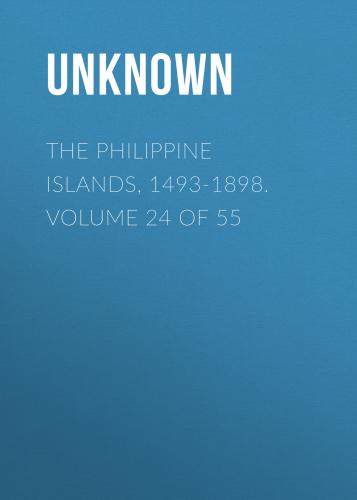30
Fray Alonso Ruiz was a native of Coimbra, Portugal, and professed in the Salamanca convent in 1574. He was minister of the village of Aclán in 1602, and of San Nicolás de Cebú in 1607, sub-prior of the convent of Manila and master of novitiates in 1611, definitor and prior of Guadalupe in 1617, and prior of Taal in 1620. He afterward served in a number of Pampanga villages, and died in that of Minalin in 1640. See Pérez’s
31
Possibly an error for Jerónimo Cavero, who ministered in certain Luzon villages from 1596 to 1611, and attained great fluency in the Ilocan language. He became definitor, and examiner and president of the provincial chapter of 1617. He died in 1622. See Pérez’s
32
Guimarás, opposite Iloilo.—Coco.
33
Fray Juan de Lecea was a native of Mondragón in the province of Vizcaya, and took his vows in the convent of Burgos. Arriving at the Philippines he was destined for the Bisayas, laboring in various missions in that district from 1600 to 1618, during which time he filled several ecclesiastical offices. He died in 1618 at Otón. See Pérez’s
34
Fray Silvestre Torres, a native of Córdoba, was missionary in Japan in 1616, subprior of the convent of San Pablo in Manila in 1617, minister of Malate in 1618, and prior of Ternate 1620–1623. On returning to Manila he had charge of the convent of Batangas, and died in the Manila convent in 1626. See Pérez’s
35
Fray Diego Oseguera was a choir student in 1607, minister of Mambúsao in 1611 and of Baong in 1614. He was especially useful in quieting the Indians who were in rebellion in the Bisayas. He died in 1615. See Pérez’s
36
Francisco Encinas, S.J., was born at Avila in 1570, and took his vows in 1596. After going to the Philippines, he taught grammar for some time, and then spent more than thirty years in the Bisayas. Having been sent to Rome as procurator for his order, in 1626, he was captured by the Dutch; but, after ransom, returned to the Philippines in 1632, and died at Manila, January 11, 1633. He was equally versed in Tagál and the Bisayan speech. See Sommervogel’s
37
Fray Juan de Montemayor was confessor to Governor Juan de Silva and a prominent orator. He was stationed at Malate 1614–1620, being appointed provincial secretary in the latter year. He was procurator-general in 1621, prior of Santo Niño de Cebú in 1623, missionary at Pásig, 1625–1629, of Parañaque in 1626, provincial chronicler in 1630, and prior of Guadalupe in 1635. He died at Manila in 1638. See Pérez’s
38
Fray Agustín Mejía was a Mexican missionary, and after going to the Philippines served in mission work in México in 1608, in Bacolór in 1611, in Guagua in 1614, and in México in 1617. He was prior of Manila in 1615, definitor, visitor, and vicar-provincial; and died in 1630, leaving a volume of Ilocan verses, the “Life of San Barlám y Jósaphat,” which remained many years in the convent of Bantay. See Pérez’s
39
Fray Pedro Lasarte (
40
For sketches of these Augustinians, see Pérez’s
41
Pérez mentions no missionary by this name.
42
Evidently an error for Fray Miguel de Suárez. He was from the branch of the order in India. In the Philippines, he served as a Tagál and Visayan missionary, laboring in Batan in 1605, in Masbate in 1607, in Ibahay in 1611, in Aclán in 1614, in Panay in 1617, in Batangas in 1621 and 1633, in Tanauan in 1623, in Tambobong in 1626, in Taal in 1629, in Bugason in Bisayas in 1630, in Guiguinto in 1632 and 1639, in San Pablo de los Montes in 1636, and in Caruyan in 1641. He was also procurator-general in 1620, and prior of the convent of Cebú in 1638, dying in 1642. See Pérez’s
43
In the unfortunate event which Father Medina mentions with as much minuteness as candor, two important points must not be overlooked by the judicious reader, which were the cause of this unfortunate deed. One was the extreme harshness of the provincial in his government, which must have been very excessive.... The imposition of new commands must have been very heavy for the religious, since even laymen intervened with the provincial, either for him to moderate unnecessary harshness or to renounce the provincialate. The second fact which also enters strongly into this case, is human passion exasperated even to obscuring the intelligence, and personified in Father Juan de Ocadiz, … a man peevish and melancholy.... Hard beyond measure must he have thought the measures taken against him. He saw in the distance his perpetual dishonor, yet did not have the virtue sufficient to resign himself; and, instigated by the spirit of evil, perpetrated the crime which he expiated with his own life.—Coco.
44
Literally, a sack containing one thousand pesos in silver.
45
There were eleven Augustinians martyred, and they received beatification from Pius X in 1867.—Coco.
46
Equivalent to the English proverb, “Misfortunes never come singly.”
